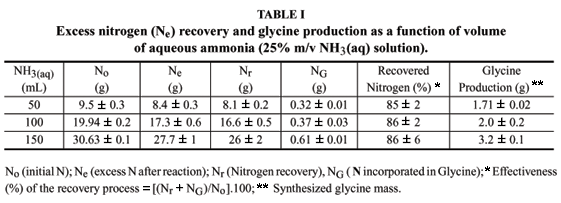This work describes a method for 15N-isotope-labeled glycine synthesis, as well as details about a recovery line for nitrogen residues. To that effect, amination of alpha-haloacids was performed, using carboxylic chloroacetic acid and labeled aqueous ammonia (15NH3). Special care was taken to avoid possible 15NH3 losses, since its production cost is high. In that respect, although the purchase cost of the 13N-labeled compound (radioactive) is lower, the stable tracer produced constitutes an important tool for N cycling studies in living organisms, also minimizing labor and environmental hazards, as well as time limitation problems in field studies. The tests were carried out with three replications, and variable 15NH3(aq) volumes in the reaction were used (50, 100, and 150 mL), in order to calibrate the best operational condition; glycine masses obtained were 1.7, 2, and 3.2 g, respectively. With the development of a system for 15NH3 recovery, it was possible to recover 71, 83, and 87% of the ammonia initially used in the synthesis. With the required adaptations, the same system was used to recover methanol, and 75% of the methanol initially used in the amino acid purification process were recovered.
stable isotope; glycine; amino acid





